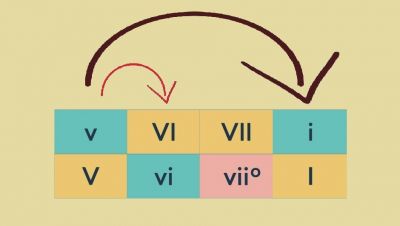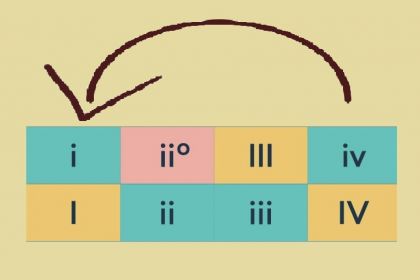Music Theory
Deceptive cadence: chord progressions and song examples

Roman numerals indicating chords of minor and major scales
In music, cadences play a crucial role in the organization of musical phrases and sentences. The concept of cadences is applied in a variety of musical forms to facilitate a more coherent perception of a composition, just as punctuation contributes to understanding and correct reading of a written text. Musical cadences imply certain harmonic, melodic, and rhythmic configurations that create a sense of resolution at the end of a sentence, period, or piece of music.
Harmonic cadence is a chord progression that uses harmonic functions of the tonic, subdominant, and dominant in combinations to explicitly signal the closure of a musical form or its sub-sections.
In classical music, a composition, period, or section is usually closed with a strong cadence that features all three harmonic functions in their most natural sequence: tonic–subdominant–dominant–tonic or T–S–D–T. In these cadences, the subdominant function can be represented by chords built on the fourth, sixth, and second scale degree, while the dominant function invariably contains the chords rooted in the fifth scale degree.
In this example of a typical final progression, the chords are marked with Roman numerals to show the corresponding scale degrees in which these chords rooted. Chord symbols in C major, as well as the sequence of diatonic functions, are also clearly shown:
- I–vi–IV–V–I or C–Am–F–G–C or T–T–S–D–T
In this chord sequence, the conflict between subdominant and dominant functions is effective in creating certain expectations for the tonic chord to come after the dominant chord of the fifth scale degree. The musical turnaround from V to I is the essential sequence called authentic cadence and can be perfect or imperfect depending on the voicing of the chords.
A cadence is considered to be deceptive, interrupted, or false when a dominant chord of the fifth scale degree is followed by any chord other than the tonic chord.
Dominant chords in deceptive cadences are often followed by chords of the sixth scale degree called the submediant. Replacing the tonic chord with the submediant chord results in a sound that is both unexpected and natural since these chords share a pair of identical notes.
Interrupted cadences are used in songs to create repetition of the last verse line, and in instrumental music, they can be applied to further develop chord chains in order to close a particular music section. The subdominant chord rooted in the fourth scale degree is at its most natural when it follows the submediant chord that has caused the initial interruption of the authentic cadence.
Here is an example of how to interrupt the authentic cadence with a submediant triad using the previously-mentioned chord chain:
- I–vi–IV–V–vi–IV–V–I or C–Am–F–G–Am–F–G–C or T–T–S–D–T–S–D–T
Deceptive cadence has become a common technique in classical music and can be found in most compositions starting with the Baroque era. Popular and genre music also finds a place for it, so it won't be too difficult to find songs that utilize this iconic trick.
A good example of the interrupted cadence written according to the canons of classical music is observed in the song I Will by The Beatles released on their 1968 White Album. Here is the harmonic analysis of the song's chord chain for each line of the verse:
- F–Dm7–Gm7–C7 or I–vi7–ii7–V7
- F–Dm–Am or I–vi–iii
- F7–B♭–C7–Dm–F or I7–IV–V7–vi–I
- Bb–C7–F–Dm7–Gm7–C7 or IV–V7–I–vi7–IV–V7
The first line ends with the dominant chord of the fifth scale degree, showing the harmonic turnaround called a half cadence and creating a sense of expectation of the tonic chord which then promptly appears at the beginning of the second line. The next cadence with the dominant chord is found in the third line of the verse, where the fifth scale degree chord is resolved by the following submediant chord. Further chord progression contains the classic cadence formula I–IV–V–I, followed by another half cadence that closes the verse in anticipation of the next section.
Listen to I Will by The Beatles:
The iconic Every Breath You Take, released by the English new wave band The Police on their 1983 Synchronicity album, reveals an example of a less constrained use of the deceptive cadence. The song's intro and verses are entirely based on a looped chord chain that features the following interrupted cadence: A♭–Fm–D♭-E♭-Fm or I–vi–IV–V–vi.
Listen to Every Breath You Take by The Police:
It should be noted that the false cadence in popular songs often does not contain a submediant chord, while in the classical canon, the usage of chord sequences rooted in the fifth and sixth scale degrees is rather standard.



